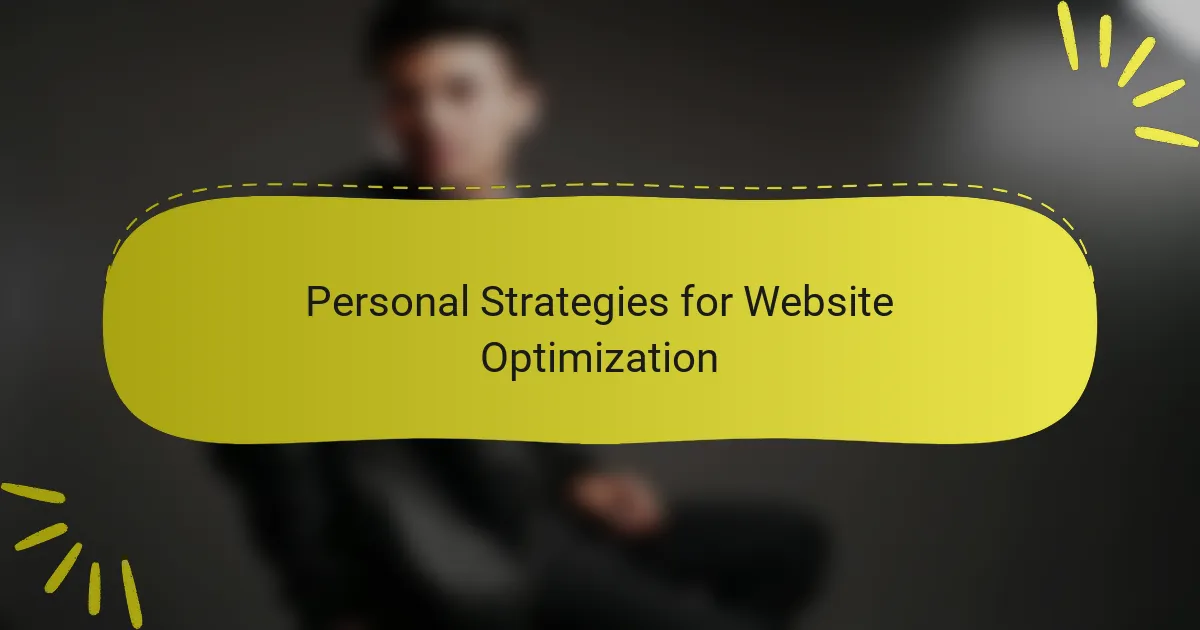Key takeaways
- Squarespace is a user-friendly platform ideal for creating professional websites without extensive coding knowledge, featuring beautiful templates and e-commerce integration.
- Key benefits include an intuitive drag-and-drop interface, built-in SEO tools, responsive design, and reliable customer support.
- Optimizing a Squarespace website involves compressing images, utilizing SEO features, and regularly reviewing analytics to enhance user experience and performance.
- Common mistakes to avoid are neglecting mobile optimization, overcomplicating navigation, and failing to regularly update content or use analytics effectively.

What is Squarespace for Websites
Squarespace is a user-friendly website building platform that allows individuals and businesses to create beautiful, professional-looking websites without extensive coding knowledge. I remember my first experience using it—I was impressed by how intuitive the interface was. Have you ever felt overwhelmed by technical jargon? Squarespace simplifies that, making website creation accessible for everyone.
Many creative professionals, like bloggers and photographers, turn to Squarespace for its stunning templates and seamless integration of e-commerce features. I often marvel at the range of design options available, allowing me to tailor my website to reflect my personal brand. It’s like having a blank canvas to express myself, which is incredibly empowering.
Moreover, Squarespace provides reliable hosting and regular updates, which brings peace of mind. I appreciate that I can focus on my content rather than worrying about technical issues. Isn’t it reassuring to know that your website is in capable hands, allowing you to pursue your creative passions?

Benefits of Using Squarespace
Using Squarespace has been a game-changer for my website, particularly in the fast-paced realm of digital fashion. The platform’s sleek templates allow me to create visually stunning layouts that reflect the aesthetic of my brand effortlessly. Every time I update my portfolio or launch a new feature, I appreciate how Squarespace handles both design and functionality.
The ease of use is another major benefit. I remember when I first ventured into web design, feeling overwhelmed by coding and complex design software. Squarespace took that stress away, allowing me to focus on my content and creative vision instead.
Here are some key benefits I’ve enjoyed from using Squarespace:
- Intuitive drag-and-drop interface, perfect for beginners.
- Beautiful, professionally designed templates that cater to various styles.
- Built-in SEO tools help improve online visibility.
- Responsive customer support for quick troubleshooting.
- Integrated e-commerce options to effortlessly sell products or services.

Key Features of Squarespace
When I first started using Squarespace, I was impressed by its elegant design templates that not only look professional but also make my digital fashion magazine stand out. The ease of customization meant I could reflect my unique style without needing a background in web development. What really sold me were features like built-in SEO tools, which take the guesswork out of getting my content noticed online.
Another feature I find invaluable is the mobile-responsive design. It’s reassuring to see my website look amazing on smartphones and tablets, which is crucial since so many readers access content on the go. Additionally, Squarespace’s analytics tools provide insightful data on visitor trends, helping me make informed decisions about content and marketing strategies.
Now, let’s look at a comparison of Squarespace’s key features with a couple of alternative platforms.
| Feature | Squarespace | Wix | WordPress |
|---|---|---|---|
| Design Flexibility | High-quality, customizable templates | High, but can look overly template-like | Very High, but requires more technical know-how |
| SEO Tools | Built-in, user-friendly | Basic tools available | Advanced plugins and tools |
| Mobile Responsiveness | Fully responsive | Responsive, but varies by template | Responsive, but dependent on theme |
| Analytics | Comprehensive yet easy to use | Basic analytics | Advanced analytics with plugins |

Steps to Optimize with Squarespace
When optimizing my website with Squarespace, I focus on a few key steps that make a noticeable difference. First, I always ensure my images are optimized as this significantly impacts loading time. I remember the excitement of launching my site, only to realize that high-resolution images were slowing everything down. Now, I compress and resize images before uploading, which has made a huge improvement in user experience.
Another crucial aspect is using built-in SEO features. Squarespace offers tools for adding titles, descriptions, and alt text, which I’ve found essential for search visibility. Initially, I overlooked these options, thinking they wouldn’t matter much, but once I started utilizing them, my site traffic saw a significant uptick. Little details truly make a big difference!
Lastly, I regularly review my site’s analytics to understand user behavior. This helps me identify which pages are popular and where my traffic is coming from. It’s like having a bird’s-eye view of my audience, allowing me to tailor my content more effectively.
| Step | Description |
|---|---|
| Image Optimization | Compress and resize images before uploading to enhance loading speeds. |
| SEO Utilization | Use Squarespace’s SEO features to add titles, descriptions, and alt text to improve search visibility. |
| Analytics Review | Regularly check site analytics for insights on user behavior and traffic sources. |

Personal Strategies for Website Optimization
When I first started using Squarespace for my digital fashion magazine, I was overwhelmed by the number of options available for optimization. But as I delved deeper, I discovered that simple adjustments often had a significant impact on performance. For instance, prioritizing image compression not only improved load times but also kept my visuals sharp and engaging, which is crucial in the fashion world where aesthetics matter.
To make my website more user-friendly and visually appealing, I implemented several strategies that have worked wonders:
- Image Formats: I always use efficient formats like JPEG for photos and PNG for graphics to reduce load times.
- Consistent Branding: I incorporate a cohesive color scheme and typography to create a recognizable brand identity.
- SEO Best Practices: I focus on optimizing meta descriptions and using alt texts for images, helping search engines understand and promote my content.
- Mobile Optimization: Ensuring my site looks great on mobile devices has expanded my audience significantly, as many readers browse on their phones.
- Regular Updates: I maintain a blogging schedule to keep the content fresh, which helps with retention and return visits.
These personal strategies not only enhanced my site’s performance but also enriched the experience for my readers.

Common Mistakes to Avoid
When I first began optimizing my website on Squarespace, I quickly learned that certain pitfalls could derail my efforts. One common mistake is neglecting to utilize the built-in SEO tools that Squarespace provides. I remember the frustration of seeing little traffic because I didn’t take the time to fill out image alt text and meta descriptions. These elements may seem minor, but they play a significant role in how search engines rank your site.
Another mistake I see frequently is an overcomplicated navigation structure. In the early days of my digital magazine, I thought having multiple layers of menus showcased my content better. Instead, it confused visitors and made it harder for them to find what they wanted. Keeping it simple not only enhances user experience but also helps retain visitors.
Here are some common mistakes to avoid:
- Ignoring mobile optimization, as most users browse on their phones.
- Failing to regularly update content, which can affect traffic and engagement.
- Overloading pages with too many visuals, which can slow down load times.
- Not using analytics to track user behavior and make informed adjustments.
- Underestimating the importance of clear calls-to-action, which guide readers effectively.